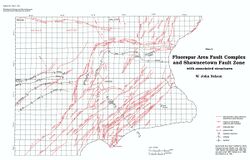Hicks Dome
Part of the Fluorspar Area Fault Complex
Location
Western Hardin County (J-7 and pl. 2)
References
S. Weller et al. 1920, J. Weller et al. 1952, Brown et al. 1954, Clegg and Bradbury 1956, Heyl and Brock 1961, McGinnis and Bradbury 1964, Baxter and Desborough 1965, Baxter et al. 1967, Heyl et al.1965, Zartman et al. 1967, Hook 1974, Trace 1974, Nelson and Lumm 1987, Bradbury and Baxter 1992
Description
Hicks Dome, a cryptovolcanic feature in the northwestern part of the Fluorspar Area Fault Complex, played a key role in the structural evolution of the region.
The roughly circular dome has prominent topographic expression on aerial photos and satellite images. Middle Devonian chert and limestone form a hill at the center. Surrounding this is a circular valley underlain by shale of the New Albany Group. Farther outward, alternating resistant and weak Valmeyeran and Chesterian strata produce concentric cuestas and strike valleys. Hicks Dome is approximately 10 miles (16 km) in diameter and its total structural relief is approximately 4,000 feet (1,200 m). Flanking dips increase to a maximum of about 20° (as much as 45° locally) about 1 mile (1.6 km) out from the apex and gradually diminish farther outward.
Ultramafic dikes, small stocks, and diatremes radiate from the center of Hicks Dome along a northwest-trending axis coinciding with the broad Tolu Arch that crosses the Fluorspar District. The rocks are dated radiometrically as early Permian (Zartman et al. 1967). Highly brecciated rock crops out near and at the apex of Hicks Dome (fig. 41) and was also encountered in a test well drilled there. Rotary drill cuttings from this site were radioactive and contained unusual concentrations of fluorite, apatite, and metal sulfides (Brown et al. 1954). Bradbury et al. (1955) reported small quantities of uranium in outcrop samples from the dome.
The small radial and arcuate faults that surround Hicks Dome apparently developed during its formation. The northwest- trending mineralized block faults that cross Hicks Dome are younger than the dome and ultramafic intrusions.
The origin of Hicks Dome is clearly related to igneous activity, but no pluton or laccolith at depth is indicated, as in the case of Omaha Dome. The borehole at the apex encountered much breccia, but no conclusively igneous rock was identified (Brown et al. 1954). An aeromagnetic survey by McGinnis and Bradbury (1964) showed no magnetic high beneath the dome, as would be expected if a large mafic body were still in place; however, the survey did indicate a strong magnetic high, interpreted as a mafic pluton, about 6 miles (10 km) northeast of the apex.
Bradbury and Baxter (1992) described three types of breccias at Hicks Dome: shatter breccias, vent breccias, and carbonatitic breccias. Like most previous researchers, Bradbury and Baxter attributed Hicks Dome and its associated breccias to explosive, alkaline igneous activity at depth. The intense fracturing at the juncture of the Reelfoot Rift and Rough Creek Graben provided pathways for mantle-derived magmas to intrude into the sedimentary column.
Compare with the OMAHA DOME, DES PLAINES DISTURBANCE, and GLASFORD STRUCTURE.

